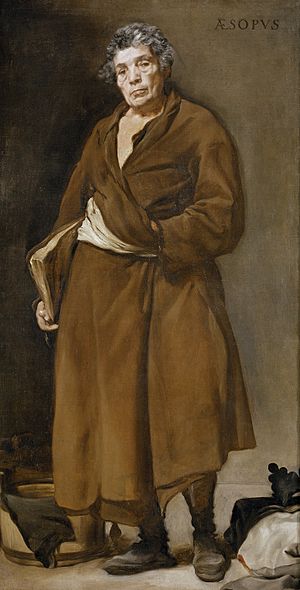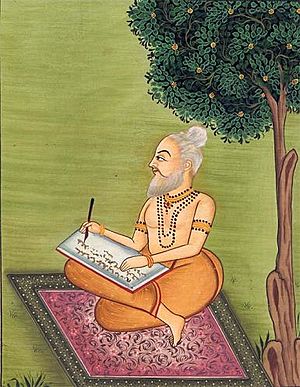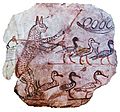Fable facts for kids
A fable is a short story that teaches a lesson or a moral. Fables often have a funny side, but their main goal is to share wisdom. These stories usually jump right into the action, without a long introduction to the characters. The characters in a fable can be people, animals, or even objects. When animals or objects are used, they think and talk like humans, even if they still act like their animal or object selves. For example, a clay pot in a fable might say it's scared of breaking.
The stories in fables are usually very simple. You don't need to know everything about the characters, just one important thing about them. This is why animals are often used in fables. They usually have the same characteristics or personalities in different stories, which makes them easy to understand:
- A lion is noble (brave and honorable).
- A rooster is boastful (likes to show off).
- A peacock is proud.
- A fox is cunning (clever and tricky).
- A wolf is fierce (wild and scary).
- A horse is brave.
- A donkey is hard-working.
The most famous fables are believed to have been told by Aesop, who lived in ancient Greece around 550 BC. Many fables are so well-known that their lessons have become common English sayings.
For example:
- If someone says "sour grapes!", they are thinking of "The Fox and the Grapes". This fable is about a fox who saw a beautiful bunch of grapes hanging on a vine. He really wanted to eat them, but they were too high up. He tried and tried to jump high enough to reach them. When he was too tired to jump anymore, he walked away saying, "I bet those grapes were sour anyway!"
- So, if a person sees something nice they want but can't have, and then pretends they didn't want it in the first place, that way of thinking is called "sour grapes".
- "Crying wolf" is another well-known English saying. This comes from "The Boy Who Cried Wolf". This fable is about a boy who was watching sheep. The sheep owners told him, "If a wolf comes to eat the sheep, you must shout loudly, and we will come chase the wolf away!" But the boy got lonely. So, he shouted "Wolf! Wolf!" The people came running, but there was no wolf. They were very angry! The next day, the boy got lonely again and shouted "Wolf! Wolf!" The people came running again, but still no wolf. They were even angrier! On the third day, the boy saw a large grey animal hiding behind the rocks, watching the sheep. He cried "Wolf! Wolf!" as loudly as he could. But this time, no one came to chase the wolf away. At the end of the day, when the people came to check on him, they found nothing left but his bones.
- So, if a person often makes a big fuss to get attention, or if they say something bad has happened when it hasn't, people might stop paying attention to them. Then, if something truly goes wrong, no one will believe them.
Contents
The History of Fables
Fables are one of the oldest types of folk stories. They have been shared for thousands of years, mostly by people telling them to each other, rather than by writing them down. You can find fables in the stories of almost every country around the world.
Aesop's Fables
The most famous collection of fables in the Western world is called Aesop's Fables. These stories are linked to a legendary slave named Aesop, who lived in ancient Greece around 550 BC. Many well-known fables from Aesop include "The Crow and the Pitcher", "The Tortoise and the Hare", and "The Lion and the Mouse".
In ancient Greece and Rome, fables were an important part of school. Students would learn fables, make them longer, invent their own, and use them as examples in speeches. Teachers needed many fables to teach, so they were collected into books, like those of Aesop.
Fables in Africa
African cultures have a very rich tradition of storytelling. For thousands of years, people in Africa have told stories about nature, including plants, animals, rivers, and mountains. Grandparents are highly respected in African societies and often tell stories during their retirement years. Children and adults love listening to good storytellers, especially when they act out the fables.
Joel Chandler Harris wrote African-American fables in the Southern United States, using the name Uncle Remus. His stories about animal characters like Brer Rabbit, Brer Fox, and Brer Bear are modern examples of African-American storytelling.
Fables in India
India also has a rich history of fables. Many of their gods are shown as animals with special qualities. Hundreds of fables were created in ancient India during the first thousand years BC. These stories were often told as stories inside other stories. Indian fables feature both humans and animals. The conversations are often longer than in Aesop's fables, and the animals sometimes try to trick each other. In Indian fables, humans are not always better than animals. These tales are often funny. The best examples of fables from India are the Panchatantra and the Jataka tales. These collections, like Vishnu Sarma's Panchatantra, later became famous around the world.
Older Indian epic poems like Vyasa's Mahabharata and Valmiki's Ramayana also included fables within their main stories. The most famous folk stories from the Near East were the One Thousand and One Nights, also known as the Arabian Nights.
Fables in Europe
Fables continued to be popular through the Middle Ages and became part of important European literature. In the 1600s, the French writer Jean de La Fontaine (1621–1695) believed the most important part of a fable was its moral, or lesson about how to behave. La Fontaine used Aesop's style to make fun of the royal court, the church, and the people of his time. Other writers in Europe, like England's John Gay and Russia's Ivan Krylov, copied La Fontaine's style.
Modern Fables
In more recent times, fables have appeared in children's books, but they have also been used in books for adults. Felix Salten's Bambi (1923) is a story about a character growing up, told like a fable. James Thurber used the old fable style in his books Fables for Our Time (1940) and Further Fables for Our Time (1956).
Władysław Reymont's The Revolt (1922) used animals taking over a farm to represent the Revolution of 1917. George Orwell's Animal Farm (1945) also used an animal fable to make fun of strict governments where one person has all the power.
In the 21st century, writer Sabatino Scia has written many fables he calls "western protest fables." His characters are not just animals, but also things and parts of nature. Scia's goal is the same as old fables: to show how human society works.
Fable Writers
Other pages
Images for kids
-
Animals acting like humans (anthropomorphic) cat guarding geese, Egypt, around 1120 BC.
See also
 In Spanish: Fábula para niños
In Spanish: Fábula para niños


























